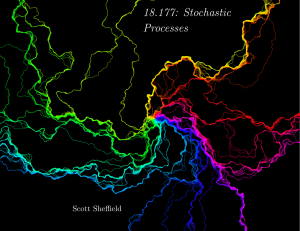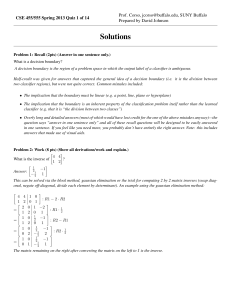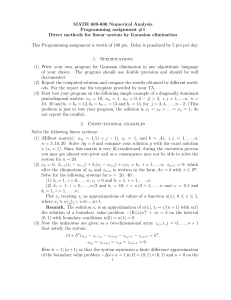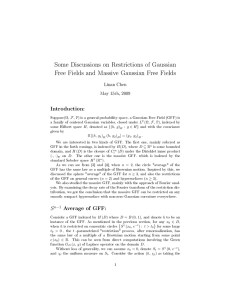MATH 177 PROBLEM SET 2 A. Answer the following DGFF questions:
advertisement
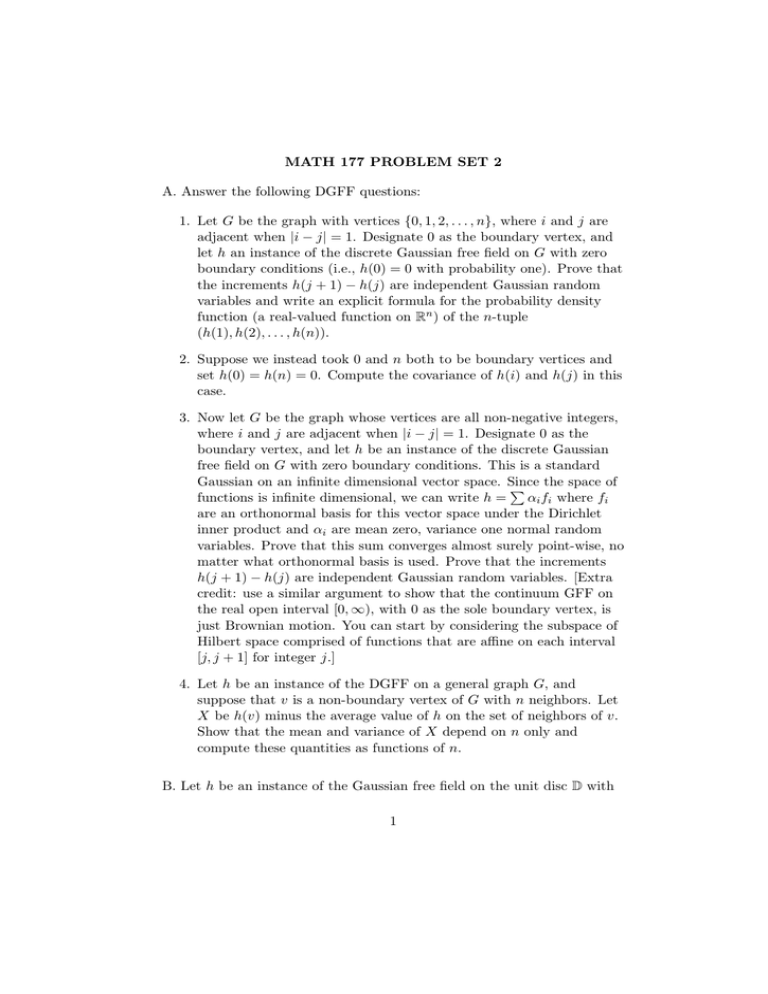
MATH 177 PROBLEM SET 2
A. Answer the following DGFF questions:
1. Let G be the graph with vertices {0, 1, 2, . . . , n}, where i and j are
adjacent when |i − j| = 1. Designate 0 as the boundary vertex, and
let h an instance of the discrete Gaussian free field on G with zero
boundary conditions (i.e., h(0) = 0 with probability one). Prove that
the increments h(j + 1) − h(j) are independent Gaussian random
variables and write an explicit formula for the probability density
function (a real-valued function on Rn ) of the n-tuple
(h(1), h(2), . . . , h(n)).
2. Suppose we instead took 0 and n both to be boundary vertices and
set h(0) = h(n) = 0. Compute the covariance of h(i) and h(j) in this
case.
3. Now let G be the graph whose vertices are all non-negative integers,
where i and j are adjacent when |i − j| = 1. Designate 0 as the
boundary vertex, and let h be an instance of the discrete Gaussian
free field on G with zero boundary conditions. This is a standard
Gaussian on an infinite dimensional vector space. Since
P the space of
functions is infinite dimensional, we can write h = αi fi where fi
are an orthonormal basis for this vector space under the Dirichlet
inner product and αi are mean zero, variance one normal random
variables. Prove that this sum converges almost surely point-wise, no
matter what orthonormal basis is used. Prove that the increments
h(j + 1) − h(j) are independent Gaussian random variables. [Extra
credit: use a similar argument to show that the continuum GFF on
the real open interval [0, ∞), with 0 as the sole boundary vertex, is
just Brownian motion. You can start by considering the subspace of
Hilbert space comprised of functions that are affine on each interval
[j, j + 1] for integer j.]
4. Let h be an instance of the DGFF on a general graph G, and
suppose that v is a non-boundary vertex of G with n neighbors. Let
X be h(v) minus the average value of h on the set of neighbors of v.
Show that the mean and variance of X depend on n only and
compute these quantities as functions of n.
B. Let h be an instance of the Gaussian free field on the unit disc D with
1
zero boundary conditions. Let h (z) denote the mean value of h on a circle
of radius .
1. Use integration by parts to prove the identity
(f, g)∇ = (f, −∆g) = (−∆f, g) when f and g are smooth and
compactly supported on D.
2. Express the random variable h (z) as a Dirichlet inner product
(h, ρ)∇ for some function ρ on D (depending on z and ) whose
Dirichlet energy is finite.
3. Compute the variance of h (0) as a function of . Can you generalize
from 0 to other values of z?
4. Show that he−t (0), viewed as a function of t, is a Brownian motion.
5. Compute the covariance of h1 (z1 ) and h2 (z2 ) under the assumption
that the balls B1 (z1 ) and B2 (z2 ) are disjoint and contained in D.
Write A (z) = eh (z) , and compute EA1 (z1 )A2 (z2 ) under the same
assumption.
C. Suppose that X is a random variable on R2 and that for each
deterministic Y ∈ R2 the random variable (X, Y ) (where (·, ·) is the usual
inner product on R2 ) is a normal random variable with mean zero and
variance (Y, Y ).
1. Prove that X is a standard Gaussian on R2 . (Hint: what can you say
about the characteristic function φ(Y ) := Eei(X,Y ) ? What about the
Fourier transform of the density function of X?)
2. Does this argument generalize from R2 to Rn ? What about infinite
dimensions?
D. Read and thoroughly understand “Gaussian free fields for
mathematicians” and the first two (plus what you can of the first four)
sections of “Liouville Quantum Gravity and KPZ”. Read Sections 1.1 to
1.4 and Sections 2 through 4 of “Conformal weldings of random surfaces:
SLE and the quantum gravity zipper”. Read “Quantum gravity and
inventory accumulation”. (All papers available at arXiv.org.)
E. Let us understand the free boundary GFF:
2
1. Show that set of real valued functions on a planar domain D, modulo
additive constants, is a Hilbert space under the DirichletP
inner
product. The free boundary GFF can be defined as h =
αi fi
where the αi are i.i.d. normal random variables and the fi are an
orthonormal basis for this Hilbert space.
2. Show that (h, ρ) is almost surely well defined for any smooth
compactly supported function ρ with mean zero.
3. As in the fixed boundary case, show that there exists a function
G(x, y) such that
Z
ρ1 (x)G(x, y)ρ2 (y)dxdy.
Cov((h, ρ1 ), (h, ρ2 )) =
D
Call this the free boundary Green’s function.
4. Compute explicitly both the free boundary and zero boundary
Green’s function for the half plane H.
5. How does Green’s function transform under conformal maps? If φ is a
0
conformal map from D to D0 , how are GD (x, y) and GD (φ(x), φ(y))
related? Is the answer the same for free and fixed boundary?
F. Let h be an instance of the free boundary GFF on H. Compute
explicitly the variance of h2 (2) − h1 (2), where in this context h (z) denotes
the mean value of h on ∂B (z) ∩ H. Compute explicitly the variance of
h1 (1) − h1 (3).
3
